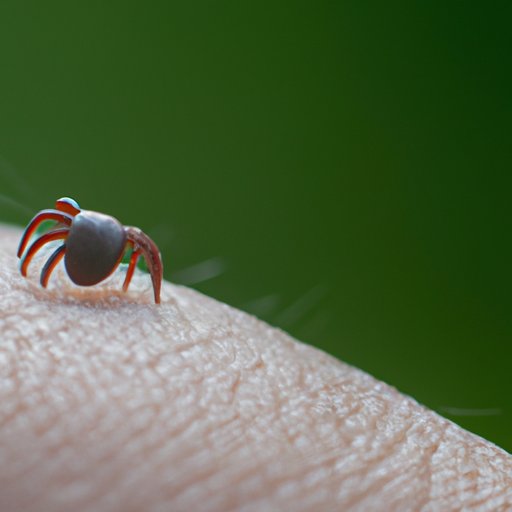
Introduction
Tick bites can be a common problem for outdoor enthusiasts, hikers, and pet owners. Not only can ticks be annoying and painful, but they can also transmit serious illnesses such as Lyme disease and Rocky Mountain spotted fever. Properly removing ticks from your skin or your pet’s fur is crucial to reducing the risk of infection. In this article, we will provide you with a comprehensive guide to safely remove ticks, including step-by-step instructions, natural remedies, prevention tips, information on tick-borne illnesses and why it’s important to remove ticks properly.
A Step-by-Step Guide: How to Safely Remove a Tick from Your Skin
Before you start, gather the necessary equipment such as fine-tipped tweezers or tick removal tools. Follow these simple steps:
- Grasp the tick as close to the skin surface as possible with tweezers or a tick removal tool without squeezing or crushing the tick.
- Pull straight upwards with steady, even pressure. Try not to twist or jerk the tick, as this can cause its mouthparts to break off and remain in the skin.
- After removing the tick, disinfect the bite site and wash your hands with soap and water.
It’s important to avoid methods such as using your fingers or twisting the tick out, which can increase your risk of infection. If you are unsure how to properly remove a tick, seek medical attention.
Using Natural Remedies to Safely Remove Ticks from Your Skin
There are various natural remedies that people claim can help to safely remove ticks, such as essential oils, vinegar, or soap and water. However, it’s important to note that there is no scientific evidence to support the effectiveness of these methods, and they may even cause skin irritation. It’s best to stick with medically-proven methods, such as using fine-tipped tweezers or tick removal tools.
Prevention and Avoidance: Tips for Avoiding Ticks and Tick Bites
The best way to prevent tick bites is to take precautions before going outdoors, such as wearing long-sleeved shirts, pants, and socks, and using insect repellent that contains DEET. After coming indoors, inspect yourself and your pets for ticks and shower within two hours of being outdoors. Keep your outdoor areas maintained and free of debris to reduce tick habitats. It’s also important to be aware of tick-prone areas and times of year, such as wooded areas during the summer months.
How to Remove a Tick from a Pet: A Comprehensive Guide
Removing ticks from pets can be a bit trickier due to their fur and tendency to move or scratch. You can use fine-tipped tweezers or tick removal tools, but be sure to avoid cutting or squeezing the tick. If you need assistance with removing a tick from a pet, consult with your veterinarian. It’s also important to keep your pets protected from ticks with tick prevention products or vaccines and monitor them after potential exposure for signs of tick-borne illness.
What to Do After a Tick Bite: Steps to Take to Stay Safe and Healthy
After a tick bite, it’s important to monitor for symptoms such as fever or rash. If you develop symptoms, seek medical attention immediately. Early diagnosis and treatment can prevent the progression of tick-borne illnesses such as Lyme disease or Rocky Mountain spotted fever. In particularly tick-prone areas or high-risk individuals, consider speaking with your healthcare provider about tick-borne illness prevention.
Why It’s Important to Remove Ticks Properly: The Dangers of Tick-Borne Illnesses
Tick-borne illnesses can cause serious health problems if they are not properly treated. Symptoms can range from mild to severe and can include fever, rash, headache, joint pain, and fatigue. In rare cases, tick-borne illnesses can even cause death. Properly removing ticks and taking preventative measures can greatly reduce the risk of infection and help keep you and your family safe.
Conclusion
Removing ticks safely and effectively is crucial to reducing the risk of tick-borne illnesses. Always use medically-proven methods such as fine-tipped tweezers or tick removal tools, avoid natural remedies, and take preventative measures to avoid tick bites altogether. Remember to monitor for symptoms of tick-borne illnesses and seek medical attention if needed. By following these tips, you can stay safe and healthy while enjoying the great outdoors.




